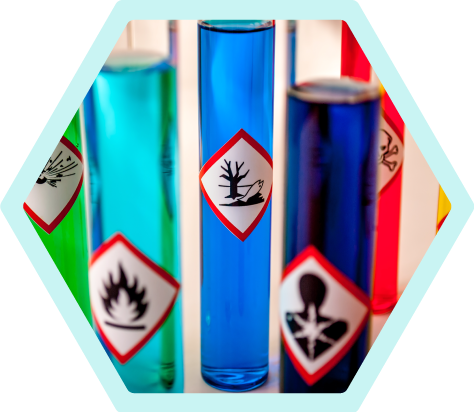Health protection in the chemical industry represents a multifaceted effort, encompassing safety and well-being of workers, communities surrounding chemical facilities, and preservation of the environment. Through the implementation of rigorous safety measures, compliance with regulations, and promotion of sustainable practices, chemical industry can continue to play vital role in modern life while minimizing its negative impacts.
Understanding, managing, and minimizing risks is our top priority, given that chemical production involves working with a variety of substances, some of which can be highly toxic, flammable, or reactive. Proper precautions can reduce these risks and prevent accidents.


In October 2020, the European Commission proposed a sustainability strategy for chemicals aimed at a toxic-free environment (COM (2020) 66 final).
The proposal offers an opportunity for European and member state authorities working on climate change, circular economy, innovation, trade, and digitalization to collaborate more closely with chemical industry in achieving the goals of the European Green Deal. Our industry supports objectives outlined in the proposal, as their realization can contribute to the economic development of EU-27, green recovery after COVID-19, and strengthening of EU’s strategic value chains.
Hungarian Chemical Industry Association’s opinion on the Commission’s proposal.
Regarding notifications at the CLP Annex VIII level, NNK CLP Information Service initiated consultations with European Chemicals Agency (ECHA) in January 2021 regarding re-labeling products already on the market with UFI codes. Based on ECHA’s standpoint, following recommendations are made:

CLP Notification Video Conference Presentations on November 3, 2020
Dr. Nikoletta Marosvölgyi, National Public Health Center: Online Notification Platform
István Murányi, Secretary-General, Personal and Home Care Association: 2nd Amendment to CLP Annex VIIa
Krisztina Nagy, REACH Expert, MOL Nyrt.: Substitute Components, Fuels
Csaba Söptei, Co-President and Director, Hungarian Paint Manufacturers Association: Poison Centers – Key Points of 2nd Amendment to CLP Annex VIII from a Paint Industry Perspective

NNK Chemical Safety and Competent Authority Department’s website provides current information.
OKBI REACH Information Service’s communication – January 2017
If you manufacture or import chemical substances into the EU in quantities of at least one ton per year, you must register them.
Examine your involvement if you are:
Failure to fulfill your registration obligations means that you cannot place your product on the market in the EU and could incur significant fines.
Some chemical substances may pose risks to human health and environment. Therefore, during the registration process, you need to collect information on the properties and uses of the substance and submit it to the European Chemicals Agency. If multiple companies want to register same substance, they should form a joint registration and share data and associated costs fairly to avoid unnecessary animal testing and reduce administrative and financial burdens.
If you pre-registered earlier, you must register substances produced or imported in quantities between 1 and 100 tons per year by May 31, 2018. If you did not pre-register, you must register immediately. If you buy the substance from an EU-based supplier, use it in industrial or professional activities, or resell it, you do not have registration obligations. However, other REACH-related obligations may apply, so it is important to seek information.

A REACH regisztrációval, vagy a REACH rendelettel kapcsolatos további kérdései esetén a REACH Tájékoztató Szolgálat szívesen áll rendelkezésre az alábbi elérhetőségeken:
Website: www.nnk.gov.hu
Email reach.helpdesk@nnk.gov.hu
Tel: +36 1 476-1134
REACH 2018 – Stay in the Market – Register Your Chemicals. European Chemicals Agency (ECHA) information on the registration of chemical substances produced or imported between 1 and 100 tons by May 31, 2018.
REACH 2018 – ECHA Press Release on Confirming Safe Use of Chemicals (July 19, 2016).
This publication provides knowledge and information related to the management and updating of safety data sheets. It includes a detailed guide to formal and content requirements of 16 sections of safety data sheets. Printed book-format guide can be requested from MAVESZ Secretariat.
CEFIC SIEF Cost Sharing (in English)
CEFIC document outlines and interprets the principles to be followed in Substance Information Exchange Forums (SIEFs) for joint registration of the same substances under REACH regulation. This opinion also contains recommendations for resolving disputes related to costs.
REACH Regulation (April 21, 2013), an informative text in Hungarian language that provides a unified structure for the regulation.
1990-2026 MAVESZ All rights reserved | web: Hedi webdesign